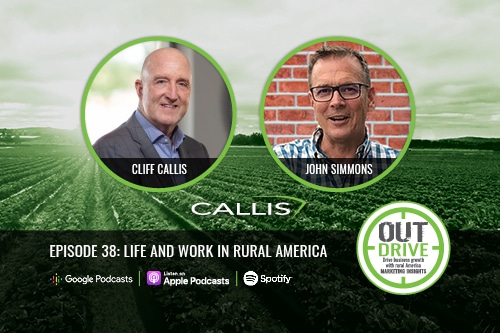Life and Work in Rural America

Growth & Collaboration with a Common-Sense Approach
OUTdrive Episode 38 with John Simmons
In this episode of OUTdrive, Cliff visits with John Simmons, Community Development Director for the city of Sedalia, Missouri. John is passionate about his city, and he and his team are instrumental in creating a pro-business environment to recruit new businesses and support existing ones.
Read more for their thoughts on business and community development, the value of the rural American workforce and effective messaging strategies to reach rural audiences. They also discuss growth and collaboration with a common-sense approach and take a look ahead toward what’s happening in rural communities.
Why Rural America is a Great Place to Do Business
Rural America is a great place to live, work and play for many reasons. New businesses are planting roots, existing businesses are expanding and families are enjoying the rural way of life. But what makes rural America such a great place to do business? A business-friendly environment is crucial, and John and the city of Sedalia understand the value of creating one.
Organized Business Development Process
One of the most important aspects of a business-friendly environment is organization. Organization and structure make transitions easier and often more successful.
“We want to make sure that when a developer comes to the city, there’s an easy process to follow,” says John. “It gives our city a reputation in the outside community that we’re a good place to do business and we’re a good place to locate a business. We’re not bureaucratic. We’re trying to get things done in a common-sense, one-stop approach.”
In addition to eliminating unnecessary steps, removing potential issues and roadblocks is crucial to creating an effective process. John credits this, as well as cooperation with other city organizations, to the city’s success in business development.
“If a developer comes in with a set of plans, they have an expectation that they’re going to run into roadblocks,” says John. “We want to make sure those roadblocks are gone and that they don’t experience them. That’s been a big part of our success, I believe, is streamlining that process, working hand in hand with the Chamber of Commerce and Sedalia-Pettis County Economic Development to make sure that Sedalia is a good experience for these investors.”
To learn more about how organizations can collaborate to achieve community growth, check out episode 11 of OUTdrive with Jessica Craig of Sedalia-Pettis County Economic Development.
Access to Transportation and Railroad
The geographical location of Sedalia, being centrally located in the United States and close to major transportation routes is another reason many businesses are choosing to operate in Sedalia and across the Midwest. Sedalia has a unique advantage as it is located at the crossroads of two major highways and just a few miles south of a major interstate highway.
A new rail spur in the Sedalia area will enable businesses like Nucor Steel to transport goods directly from their factories via railways and it has opened up a large area for future industrial development.
“I think geography has a lot to do with it, as well as access to transportation,” says John. “Certainly access to rail is going to change the complexion. Being able to roll things in on the rails instead of trucks is something that companies look for, and we’re going to be able to answer that call.”
Values of the Rural American Workforce
In addition to geographic location and streamlined processes, many companies are choosing to operate in rural America because of the strong and dedicated workforce. Access to a diverse labor basin is vital, and hard workers can be difficult to come across. However, rural America provides companies with both, a distinguishing advantage for cities like Sedalia.
“I think Sedalia demonstrates that rural work ethic, that can-do, blue-collar, get the work done ethic, which is huge, and I think we demonstrate that in the diversity of our industrial base,” says John. “We’re building everything from steel wheels to yearbook photographs to toolboxes, to engine turbines. It’s such a diverse workforce that can actually utilize their skills across the different companies. I think that these companies recognize we have a good labor basin that’s hard-working, shows up and is committed to their jobs. And I think that’s one of the key elements.”
Workers that are committed to their jobs and work hard day in and day out are a great asset for businesses, and the rural American workforce delivers these qualities and more.
Effective Messaging in Rural America
While many businesses operate in urban cities or larger metropolitan areas, they may have customers and audiences that reside in rural America. Knowing that rural consumers are unique, John shares effective messaging strategies that brands use to reach him.
“What I notice in advertising is what is quiet and nuanced. If you’re shouting at me, I’m not going to listen,” says John. “If you have a message or something that can make my brain want to know more, that’s what’s important. And you do that by not flooding me with noise and verbiage.”
John’s insights are unique to him, but the ideas lay a strong foundation for marketers to effectively reach rural audiences. Grabbing the attention of consumers is not effective by itself. Once you have their attention, you must provoke their thought process to increase engagement, retention and brand recall. John adds that effective advertising is supported by strategy and reasoning, saying, “I pay attention to nuanced, educated advertising that has a message, and not just noise.”
Effectively reaching a rural audience requires creativity, strategy and commitment. A similar commitment drives rural America and makes it such an appealing place to live, work and play. Hear more from John and Cliff on these topics and more in this episode of OUTdrive!

